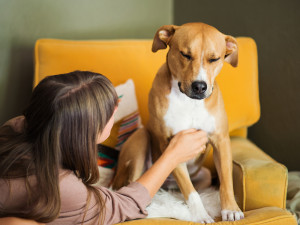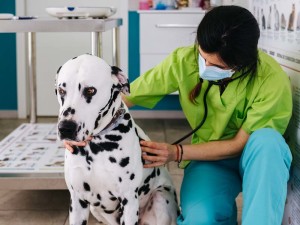Scared Stiff: How to Spot Tetanus in Dogs
Dogs can get tetanus, too – and not just from rusty nails
You’ve probably heard of a tetanus vaccine, and vaguely know that you’re supposed to get one particularly after a dirty cut, scratch from a piece of metal or a bite wound. You may even know that tetanus is often referred to as ‘lockjaw’. But beyond that, you may not have much knowledge about tetanus, including the fact that dogs can get tetanus, too.
Tetanus can be dangerous for your dog but different animal species have varying sensitivities to the tetanus neurotoxin. Horses, humans and livestock are most sensitive, and dogs are less sensitive (cats are very resistant and almost never get infected). Below, everything you need to know about tetanus in dogs, including symptoms to look out for and exactly how to treat it.
What is tetanus?
Tetanus is a rare, but very serious disease caused by a neurotoxin called tetanospasmin that is secreted by a bacterium known as Clostridium tetani. The neurotoxin affects the nervous system of dogs, which can lead to painful stiffening and paralysis of the dog’s jaw, neck and other muscles.
The toxin binds to local nerves and moves up into the central nervous system where it interferes with the release of glycine, an amino acid that also acts as an inhibitory neurotransmitter. The result: painful muscle over-activity, spasms and rigidity in the dog’s muscles. In severe cases of tetanus, a dog cannot breathe because the respiratory muscles become paralysed. In these cases, a mechanical ventilator is needed.
Tetanus bacteria are anaerobic, meaning they grow in conditions where there is no oxygen, such as a deep bite wound or puncture. Clostridia are soil bacteria and they live in dirt, so it is easy to see how a puncture on a dog contaminated with dirt would be a classic tetanus-yielding wound. Such wounds are particularly common on farms where there might be nails on the ground, ready to pierce a dog in the foot. A fight involving a bite wound and rolling around in dirt might also lead to tetanus in dogs.
Another interesting source of exposure to tetanus for dogs are grass seeds such as foxtails. However, whilst grass seed can cause a number of issues for dogs in general, it is very rare for it to lead to tetanus in the UK.
Symptoms of tetanus in dogs
The symptoms of tetanus often appear within two weeks. For many dogs, the initial signs of tetanus are subtle eye changes, which can easily be mistaken for eye disease. Symptoms include:
inability to blink
constricted pupils
sunken eyes
sensitivity to light
risus sardonicus (a sardonic grinning)
erect ears
inability to open jaw
rigid tail
sawhorse stance
difficulty swallowing
seizures
muscle spasms
walking rigidly or inability to walk
In the early stages of tetanus infection, a dog loses the ability to blink and will solely use their third eyelid to moisten their eyes. The dog may become sensitive to light because the pupil has constricted. In localised tetanus, dogs will see stiffness near the muscles closest to the initial wound, but in generalised tetanus, a dog’s muscles across their body may become more rigid and tense, leading to spasms and seizures. Some of the signs may be attributed to other toxins, such as snail bait or mouldy toxins, resulting in a misdiagnosis.
As the disease progresses, dogs with ears that hang down may develop ears that stand up straight and the facial muscles may pull back, creating risus sardonicusopens in new tab (aka a sardonic grin). In more advanced stages, dogs can no longer walk and will stand stifflyopens in new tab in what is called a sawhorse stance.
Diagnosis of tetanus in dogs
Unfortunately, there is no easy diagnostic test that can confirm tetanus in dogs. The diagnosis is generally made based on the visual appearance of the dog and history of the wound. Typically, there is a history of a wound in a tetanus case (usually in the preceding one to two weeks) but sometimes the wound may have gone unnoticed by the human and this important clue is not available.
It’s possible to measure antibody levels against the tetanus toxin, but this has not been widely used in clinical settings. Attempting to culture Clostridium tetani from the wound, as a way to support a diagnosis, doesn’t typically work.
Treatment of tetanus in dogs
The first step in treatment is antibiotics to kill the Clostridia toxin. The good news is that good old-fashioned penicillin does the trick. In addition to the antibiotics, sedation and anti-seizure medications may be necessary to control the muscle spasms and/or seizures.
Nursing care may also be needed and requires a darkened room with minimal stimulation and soft bedding to prevent bedsores. The clenched jaws caused by tetanus can be problematic for feeding so a liquid diet is often necessary. Improvement is generally noted within the first week of therapy but complete recovery can take up to a month.
A controversial treatment called Tetanus Antitoxin Behring may be an option if the tetanus is diagnosed early. Antitoxin is an antibody solution (a blood product) generated by either horse or human blood, which works by binding and destroying the tetanus toxin, preventing it from attaching to the dog’s cells. Unfortunately, if the toxin has already attached to the cells, the antitoxin will not work; in fact, the tetanus antitoxin can actually cause significant side effects in dogs, so your vet will weigh the risks versus the benefits.
What about a tetanus vaccine?
Tetanus toxoid is the tetanus vaccine most of us (humans) have had at one time or another. It is a vaccine against the tetanus toxin and it is part of the NHS vaccination schedule. Because dogs are much more resistant to tetanus than humans, regular vaccination against tetanus is not recommended for them.
Luckily, tetanus is not common in dogs. But the potential does exist, so it’s always good to have this knowledge – you never know what kind of mischief your dog could get into.
Disclaimer alert: this article is here to share information and should not be taken as fact or medical advice. Always talk things over with your vet when making decisions, and use your best judgement.







